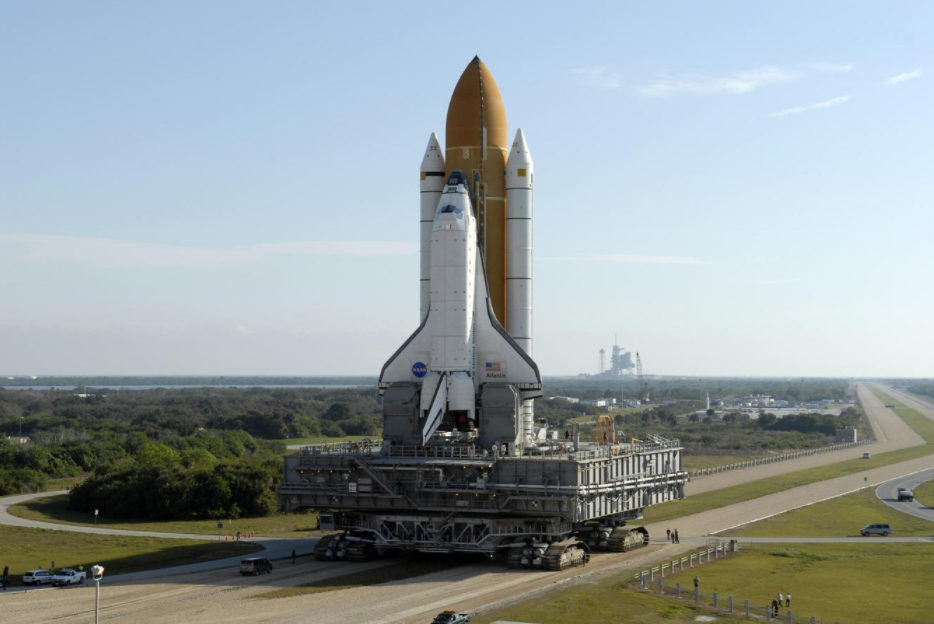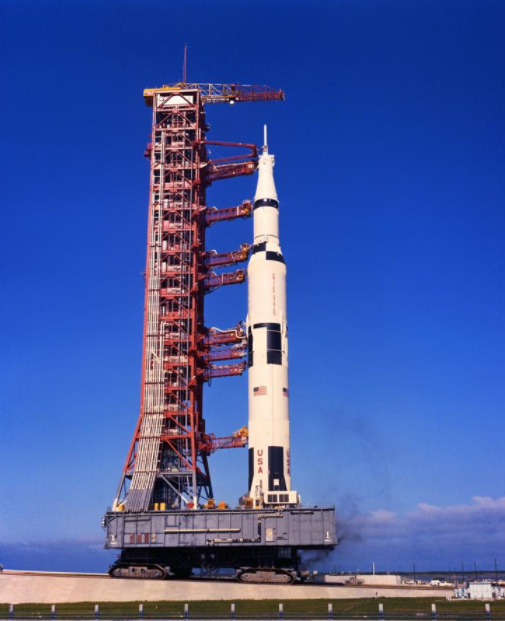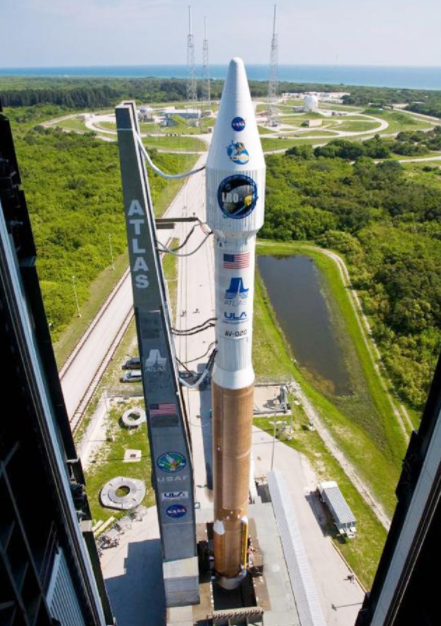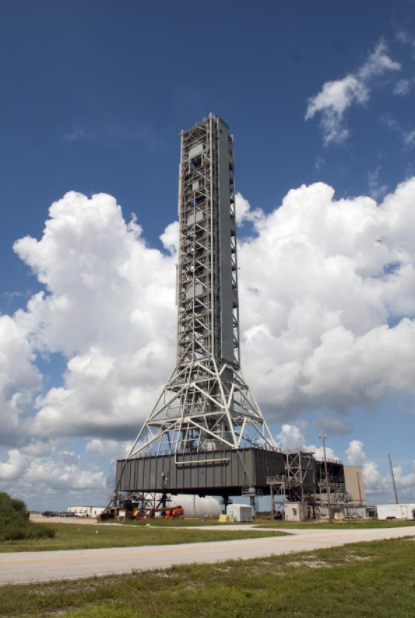A mobile launcher platform, also known as mobile launch platform, is a steel structure used to support a large multistage space vehicle which is assembled (stacked) vertically in an integration facility (e.g. the Vehicle Assembly Building) and then transported by a crawler-transporter (CT) to a launch pad. This becomes the support structure for launch. Alternatives to this method include horizontal assembly and transport to the pad, as used by Russia; and assembling the vehicle vertically on the launch pad, as the United States used for smaller launch vehicles. The use of mobile launcher platforms dates back to the "Integrate-Transfer-Launch" (ITL) concept developed in 1965 for the Titan III launched from Cape Canaveral Space Launch Complex 40 and 41, and was adopted in 1966 for the Saturn V vehicle launched from Kennedy Space Center Launch Complex 39. Launch Complex 39 and 41 continue to use this concept.
- steel structure
- multistage
- integrate-transfer-launch
1. Historical Use
1.1. Saturn V and Space Shuttle



From 1967 to 2011, three platforms were used at the LC-39 to support NASA's launch vehicles, and will be used for commercial launch vehicles. Formerly called Mobile Launchers (ML), the mobile launcher platforms were constructed for transporting and launching the Saturn V rocket for the Apollo program lunar landing missions of the 1960s and 1970s. Each ML originally had a single exhaust vent for the Saturn V's engines. The MLs also featured a 380-foot-tall (120 m) Launch Umbilical Tower (LUT) with nine swing arms that permitted servicing of the vehicle on the launch pad, and swung away from it at launch.
After the Apollo program, the bases of the MLs were modified for the Space Shuttle, and renamed as Mobile Launcher Platforms (MLP). The launch umbilical towers from ML-2 and ML-3 were removed. Portions of these tower structures were erected at the two launch pads, 39A and 39B. These permanent structures were known as the Fixed Service Structures (FSS). The LUT from ML-1 was taken apart and stored in the Kennedy Space Center's industrial area. Efforts to preserve the LUT in the 1990s failed due to a lack of funding, and it was scrapped.[1]
In addition to removal of the umbilical towers, each Shuttle-era MLP was extensively reconfigured with the addition of two Tail Service Masts (TSM), one on either side of the main engine exhaust vent. These 9.4 m (31 ft) masts contained the feed lines through which liquid hydrogen (LH2) and liquid oxygen (LOX) were loaded into the shuttle's external fuel tank, as well as electrical hookups and flares that were used to burn off any ambient hydrogen vapors at the launch site immediately prior to Main Engine start.[2]
The main engines vented their exhaust through the original opening used for the Saturn rocket exhaust. Two additional exhaust ports were added to vent exhaust from the Space Shuttle Solid Rocket Boosters (SRBs) that flanked the external fuel tank.
The Space Shuttle assembly was held to the MLP at eight holddown points using large studs, four on the aft skirt of each Solid Rocket Booster. Immediately before SRB ignition, frangible nuts attached to the top of these studs were detonated, releasing the Shuttle assembly from the platform.[3]
Each MLP weighed 8.23 million pounds (3,730 tonnes) unloaded and roughly 11 million pounds (5,000 tonnes) with an unfueled Shuttle aboard, measured 160 by 135 feet (49 by 41 m), and was 25 feet (7.6 m) high. They were carried by one of two crawler-transporters (CT), which measure 131 by 114 feet (40 by 35 m), and 20 feet (6.1 m) high. Each crawler weighs about 6 million pounds (2,700 tonnes) unloaded, has a maximum speed of about 1 mile per hour (1.6 km/h) loaded, and has a leveling system designed to keep the launch vehicle vertical while negotiating the 5 percent grade leading to the top of the launch pad. Two 2,750 horsepower (2.05 MW) diesel engines power each crawler.[4]
The MLPs were designed as part of NASA's strategy for vertical assembly and transport of space vehicles. Vertical assembly allows the preparation of the spacecraft in a ready-for-launch position, and avoids the additional step of lifting or craning a horizontally-assembled vehicle onto the launchpad (as the engineers of the Soviet space program chose to do).
Mobile Launcher Platform-1
Formerly called Mobile Launcher-3 (ML-3), Mobile Launcher Platform-1 (MLP-1) was one of three MLPs used at Launch Complex 39. Saturn V and Space Shuttle launches were conducted from MLP-1 between 1969 and 2009.
It was built by Ingalls Iron Works. Construction began in 1964 and was completed with the installation of the Launch Umbilical Tower hammerhead crane on 1 March 1965.[5] The swing arms, which were constructed by Hayes International were added at a later date.
Following completion, ML-3 was used for five crewed Apollo launches; Apollo 10, Apollo 13, Apollo 15, Apollo 16 and Apollo 17.
Following the launch of Apollo 17, ML-3 was the first of the Mobile Launchers to be converted for use by the Space Shuttle. The Launch Umbilical Tower was dismantled and later partially reassembled on LC-39A[6] as that pad's Fixed Service Structure (FSS) and the base of the launch platform was modified to accommodate the locations of engines on the Shuttle. The platform was redesignated MLP-1.
In total, MLP-1 was used for 52 Shuttle launches between 1981 and 2009. It was used for the first Space Shuttle launch, STS-1, in April 1981. Following the launch of STS-119 in March 2009, it was transferred to the Constellation program. The platform was used only for the Ares I-X and was to be disassembled after the launch.[7] However, the Constellation program was canceled and the ML was left unused.
With the retirement of the Shuttle in 2011 and its planned replacement Orion spacecraft and launcher in the design and test phase, NASA converted LC-39B from Shuttle operations to support Orion launches. The Ares I-X suborbital mission utilized MLP-1, to support the stacking and launch operations. The canceled Ares I-Y would have used the same MLP.[8][9]
Following the STS-135, usable parts from MLP-1 were removed and stored in the Vehicle Assembly Building, with no plans to use the MLP again.[10]
Mobile Launcher Platform-2
Formerly called Mobile Launcher-2 (ML-2), Mobile Launcher Platform-2 (MLP-2) was one of three MLPs used at Launch Complex 39. During the late 1960s and early 1970s, it was used for Saturn V launches, and was subsequently used by the Space Shuttle.
It was built by Ingalls Iron Works.[5] The swing arms, which were constructed by Hayes International were added at a later date.
Following completion, ML-2 was used for the uncrewed Apollo 6 mission, followed by three crewed Apollo launches; Apollo 9, Apollo 12 and Apollo 14. It was subsequently used for the launch of Skylab on a Saturn V in 1973.
Following the launch of Skylab, ML-2 was the second of the Mobile Launchers to be converted for use by the Space Shuttle. The Launch Umbilical Tower was dismantled and partially reassembled to become the LC-39B[11] Fixed Service Structure (FSS), and the base of the launch platform was modified to accommodate the locations of engines on the Shuttle. The platform was redesignated MLP-2.
In total, MLP-2 was used for 44 Shuttle launches, starting in 1983. All of the orbiters except Columbia made their maiden flights from MLP-2. It was also the launch site for the ill-fated STS-51L mission, when Space Shuttle Challenger disintegrated shortly after launch, killing all seven crew members.[12]
Mobile Launcher Platform-3
Formerly called Mobile Launcher-1 (ML-1), Mobile Launcher Platform-3 (MLP-3) is one of the three MLPs originally built and used at Launch Complex 39, and the only one of them still in active use. During the late 1960s and early 1970s, it was used for Saturn V and Saturn IB launches, and later for the Space Shuttle. It will be used to launch Northrop Grumman's OmegA rocket from LC-39B (utilizing Crawler Transporter 1) starting in 2021.[13]
It was the first Mobile Launcher to be constructed, and was built by Ingalls Iron Works.[5] The swing arms, which were constructed by Hayes International, were added at a later date.
The first launch from ML-1 was the maiden flight of the Saturn V, and the first launch from LC-39, Apollo 4. Following this, it was used for two crewed Apollo launches: Apollo 8 and Apollo 11. After NASA decided to move Saturn IB launches from LC-34 to LC-39B, ML-1 was modified by the addition of a structure known as the Milkstool, which allowed the Saturn IB to use the same Launch Umbilical Tower as the much larger Saturn V. Three manned flights to Skylab, and the Apollo launch for the Apollo-Soyuz Test Project, were conducted from ML-1 using the Milkstool.
Prior to the scrapping of the LUT in 2004, there was a campaign to rebuild and preserve it as a memorial to Project Apollo.[14] The crew access arm is preserved at the Kennedy Space Center Visitor Complex on the upper level of the gift shop.[15]
Following the launch of Skylab, ML-1 was the last Mobile Launcher to be converted for use by the Space Shuttle. The LUT and Milkstool were dismantled and placed into storage, and the base of the launch platform was modified to accommodate the locations of engines on the shuttle. The platform was redesignated MLP-3.
In total, MLP-3 was used for 29 Shuttle launches, starting in 1990. It was the least used of the three MLPs.
Titan III and Titan IV
Titan III and Titan IV rockets launched from SLC-40 and SLC-41 utilized MLPs to decouple assembly of the launch vehicle from launch. This was meant to enable simultaneous assembly of multiple launch vehicles as part of the Titan's Integrate-Transfer-Launch (ITL) concept, allowing a high flight rate from a small number of launchpads.[16]
2. Current Use

2.1. Atlas V
The Atlas V utilizes an MLP when launching from SLC-41. For those launches the rocket is stacked on its MLP in the 280-foot-tall (85.4 m) Vertical Integration Facility (VIF), and is then rolled-out over 600 yards (550 m) to the launchpad.[17] The design of this MLP is derived from the MLPs used by the Titan III and IV rockets.
2.2. Vulcan
ULA has designed and built a MLP for their later Vulcan rocket, derived from the design of the Atlas MLP.[18]
2.3. H-IIA and H-IIB
The Japanese H-IIA and H-IIB utilize MLPs when launching from the Yoshinobu Launch Complex.
3. Future Use
3.1. Space Launch System

Between 2009 and 2010, another MLP was constructed as part of the Constellation program, known as Mobile Launcher-1 (ML-1). Since the cancellation of the program in 2010, ML-1 was converted for the Space Launch System Block 1, with various phases of construction between 2013 and 2018. The biggest modification to the ML-1 was on the platform's base, where engineers increased the size of a 22 square feet (2.0 m2) exhaust duct to a rectangle stretching 60 by 30 feet (18.3 by 9.1 m) and strengthened the surrounding structure. The SLS will weigh more than twice as much as the planned Ares I rocket. The Ares I rocket would have featured a single solid-fueled first stage, while the SLS will include two large solid rocket boosters and a powerful core with four RS-25 engines. The base of the ML-1 is 25 feet (7.6 m) high, 158 feet (48 m) long, and 133 feet (41 m) wide.[19] The ML-1 also features a 355-foot-tall (108 m) Launch Umbilical Tower (LUT) with several arms that will permit servicing of the SLS on the launch pad, and will swing away from it at launch.
On June 2019, NASA awarded a contract for the design and construction of Mobile Launcher-2 (ML-2) for SLS Block 1B.[19]
3.2. Vulcan
United Launch Alliance's Vulcan will use an MLP similar in design to the one used by the Atlas V when launching from SLC-41, altered to support the former's larger design. The Vulcan MLP stands 183 ft (56 m) tall, and when complete will weigh 1.3 million pounds (590 tonnes). It will be equipped with various electronics, power-lines, and cables to support and control the rocket. For the initial Vulcan-Centaur configuration, the MLP will supply liquefied natural gas and liquid oxygen to the first stage, and liquid hydrogen and liquid oxygen to the Centaur upper stage. (As of October 2019) the basic structure has been completed, but the umbilicals and equipment have yet to be installed.[20]
3.3. OmegA
The Mobile Launcher Platform-3 (MLP-3) was acquired by Orbital ATK (who was later bought out by Northrop Grumman) to launch their future OmegA rocket with. They will use the Vehicle Assembly Building High Bay 2 to assemble the rocket, and crawler-transporter 1 to move the rocket to LC-39B for launch.
4. Sound Suppression System
Once delivered to the pad, the mobile launch platform is connected to the larger sound suppression system by large pipes which deliver a deluge of water from an adjacent water tower. Six 12-foot-high (3.7 m) towers known as "rainbirds" spray water over the MLP and into the flame deflector trenches below it, absorbing acoustic waves. The suppression system reduced the acoustic sound level to approximately 142 dB.[21]
The content is sourced from: https://handwiki.org/wiki/Astronomy:Mobile_launcher_platform
References
- "Apollo tower proposed as monument | collectSPACE". http://www.collectspace.com/news/news-020404a.html.
- Dandage, S. R.. "Design and Development of the Space Shuttle Tail Service Masts". NASA Goddard Space Flight Center Goddard Space Flight Center The 11th Aerospace Mech. Symp: 1–12. https://ntrs.nasa.gov/archive/nasa/casi.ntrs.nasa.gov/19790013204.pdf.
- Roy, Steve (November 2008). "Space Shuttle Solid Rocket Booster: Frangible Nut Crossover System". NASA. http://www.nasa.gov/sites/default/files/290339main_8-388221J.pdf. Retrieved September 28, 2016.
- "Countdown! NASA Launch Vehicles and Facilities". NASA. October 1991. pp. 16–17. Archived from the original on January 27, 2005. https://web.archive.org/web/20050127071338/http://www-pao.ksc.nasa.gov/kscpao/nasafact/pdf/countdow.pdf. Retrieved August 21, 2013.
- Benson, Charles D; Faherty, William B. "The Swing-Arm Controversy". Moonport: A History of Apollo Launch Facilities and Operations. NASA History Office. http://www.hq.nasa.gov/office/pao/History/SP-4204/ch13-3.html.
- "Photo of ML2/LUT2 on LC-39A AFTER the FSS was constructed.". https://www.nasa.gov/centers/kennedy/images/content/479677main_108-KSC-77P-160.jpg.
- Ochoa-Gonzales, Frank (2009-04-17). "Space Shuttle Program Hands over Launch Platform to Constellation". NASA. https://blogs.nasa.gov/Constellation/2009/04/17/post_1238018207796/.
- "Pad 39B suffers substantial damage from Ares I-X launch - Parachute update" (in en-US). 2009-10-31. https://www.nasaspaceflight.com/2009/10/pad-39b-suffers-substantial-damage-ares-i-x-parachute-update/.
- "Ares I Rollercoaster EES continues to evolve" (in en-US). 2008-07-08. https://www.nasaspaceflight.com/2008/07/ares-i-rollercoaster-ees-continues-to-evolve/.
- KSC, Anna Heiney. "NASA - Mobile Launcher Platforms Prepped for New Generation" (in en). https://www.nasa.gov/exploration/systems/ground/mlp_hardware.html.
- "Photo of ML2/LUT2 on LC-39A AFTER the FSS was constructed.". https://www.nasa.gov/centers/kennedy/images/content/479677main_108-KSC-77P-160.jpg.
- "Apollo to OmegA: NASA signs over legacy launcher for new rocket | collectSPACE". http://www.collectspace.com/news/news-081619a-northrop-grumman-omega-mlp-vab.html. Retrieved 21 January 2020.
- "Apollo to OmegA: NASA signs over legacy launcher for new rocket | collectSPACE". http://www.collectspace.com/news/news-081619a-northrop-grumman-omega-mlp-vab.html. Retrieved 21 January 2020.
- "Welcome Page". Save the LUT Campaign. 2004-02-12. http://www.savethelut.org/. Retrieved 2009-03-26.
- "Apollo 11 gantry arm lands in NASA gift shop (but not for sale) | collectSPACE". http://www.collectspace.com/news/news-062918a-kennedy-space-shop-apollo11-gantry.html.
- Vobejda, W. F.; Rothermel, L. J. (7 March 1966). "Positioning and Aligning the 250 Ton Solid Rocket Motors for Titan IIIC" (pdf). p. 258. https://commons.erau.edu/cgi/viewcontent.cgi?article=3080&context=space-congress-proceedings. Retrieved 24 November 2019.
- "Atlas 5 Data Sheet". https://www.spacelaunchreport.com/atlas5.html. Retrieved 24 November 2019.
- "Construction milestone achieved for Vulcan's launch platform". https://www.ulalaunch.com/explore/blog-detail/blog/2019/10/24/construction-milestone-achieved-for-vulcan's-launch-platform.
- https://www.nasa.gov/sites/default/files/718660main_mobile-launcher.pdf
- "Construction milestone achieved for Vulcan's launch platform". 24 October 2019. https://www.ulalaunch.com/explore/blog-detail/blog/2019/10/24/construction-milestone-achieved-for-vulcan's-launch-platform. Retrieved 24 November 2019.
- Warnock, Lynda. "Sound Suppression System". NASA. https://www.nasa.gov/mission_pages/shuttle/launch/sound-suppression-system.html.
